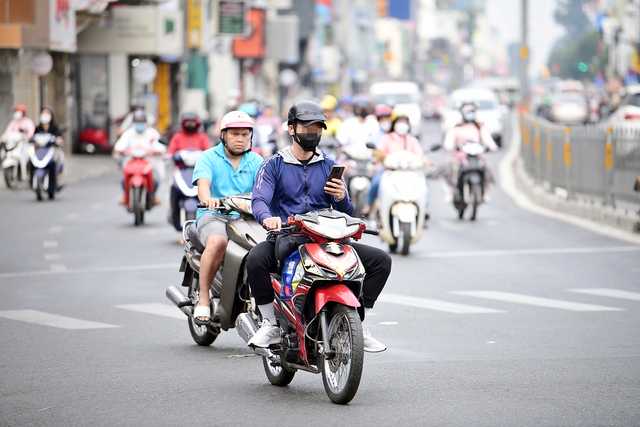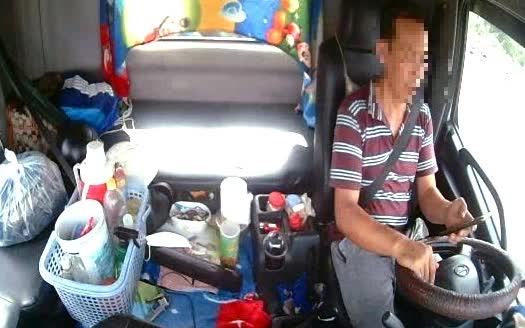
A motorcyclist uses a phone while riding in Ho Chi Minh City. Photo: Quang Dinh / Tuoi Tre
At red lights, some people scroll through their phones.
Others keep their eyes glued to the screen even after the light turns green.
Some bus drivers chat away for minutes at a time while driving.
These are not isolated incidents—they're everyday behaviors across Vietnam that are putting traffic safety at serious risk.
It has become alarmingly common to see people texting, video calling, or checking apps while operating a vehicle in the country.
The habit of using phones while driving is now so widespread, it demands urgent attention.
Many drivers continue this dangerous behavior believing they won't get caught—or worse, thinking it's harmless.
It's not just about personal responsibility
According to Vietnam's Traffic Police Department, also known for short as C08, under the Ministry of Public Security, more than 1.6 million traffic violations were handled in the first half of 2025, with 3,521 cases involving phone use while driving.
From December 15, 2024 to June 14, 2025, highway traffic police units penalized 126 cases of phone use while driving—71 of which involved passenger buses.
These numbers appear quite low compared to how common the behavior actually is.
Decree 168/2024/ND-CP, which took effect on January 1, 2025, clearly states that drivers caught using their phones while operating a car can be fined VND4–6 million (US$152–230) and have four points deducted from their 12-point driver's license.
If the violation causes an accident, the fine increases to VND20–22 million ($762–$840) and 10 points are deducted.
Similarly, motorcyclists using phones face fines of VND800,000–1 million ($30–38), and cyclists can be fined VND200,000 ($7.6).
But having laws in place is one thing—enforcing them is another.
Current surveillance systems can't always detect phone use, especially when drivers keep their phones low or out of sight.
The point-deduction mechanism lacks interagency coordination and consistency across provinces.
GPS-based monitoring is only mandatory for commercial vehicles, even though the majority of violations occur with private vehicles—which have no comparable tracking system.
In recent months, several videos have gone viral showing dangerous behavior: long-distance passenger bus drivers video chatting while driving, young people livestreaming while speeding, and a student breaking their jaw after watching TikTok while riding an e-bike.
These are not just lapses in individual judgment. They point to broader systemic issues.
For example, app-based drivers often have no choice but to use their phones for navigation or to accept ride requests.
Tinted windows, widely used in private cars, further limit visibility, making it harder for authorities to detect violations.
Moreover, current laws don't require vehicles to use clear windows or have dash cams, leaving gaps in monitoring and enforcement.
Traffic safety education often focuses on relaying regulations rather than delivering emotional, real-world experiences that lead to meaningful behavior change.
A coordinated and technological approach needed
When public awareness alone can't shift behavior, the law and technology must step in.
We need a traffic system designed to prevent risks—not just respond after violations occur.
Effective compliance will only happen when drivers are supported with clear policies, effective enforcement, and practical technological tools.
Solving this issue requires more than just fines.
We need a long-term strategy with immediate, medium-term, and long-term actions suited to Vietnam's traffic conditions.
First, law enforcement must increase on-the-ground patrols and checks, especially at traffic hotspots.
Traffic safety education should be integrated into driver training and school curricula, using real stories and consequences to create emotional impact and lasting change.
Artificial intelligence (AI) cameras should be piloted on high-traffic roads to detect handheld phone use.
Dash cam installations on private vehicles should be encouraged, and inter-agency data systems must be linked to enforce the driver's license point-deduction system more effectively.
Automated enforcement systems using big data and AI should be developed to identify dangerous driving behavior objectively and continuously.
Transportation companies must be held accountable for monitoring and training their drivers.
Tech platforms should build safer features—such as locking certain app functions when the vehicle is moving or enabling hands-free, voice-controlled operations.
As dangerous as driving under the influence
Global research consistently shows that using a phone while driving is a leading cause of distracted driving and traffic accidents.
The International Telecommunication Union has listed it among the top high-risk behaviors on the road.
According to the U.S. National Highway Traffic Safety Administration (NHTSA), distracted driving was responsible for 3,308 deaths in 2022—most involving mobile phone use.
The World Health Organization's 'Global status report on road safety 2023' warns that phone use while driving increases crash risk by four to five times.
Vietnam's National Traffic Safety Committee also reports that phone use can reduce a driver's reaction speed by up to 50 percent—slower than someone with a blood alcohol level of 80mg/100ml, a threshold commonly used in international DUI regulations.
Clearly, using a phone behind the wheel is no less dangerous than driving under the influence of alcohol.



Max: 1500 characters
There are no comments yet. Be the first to comment.